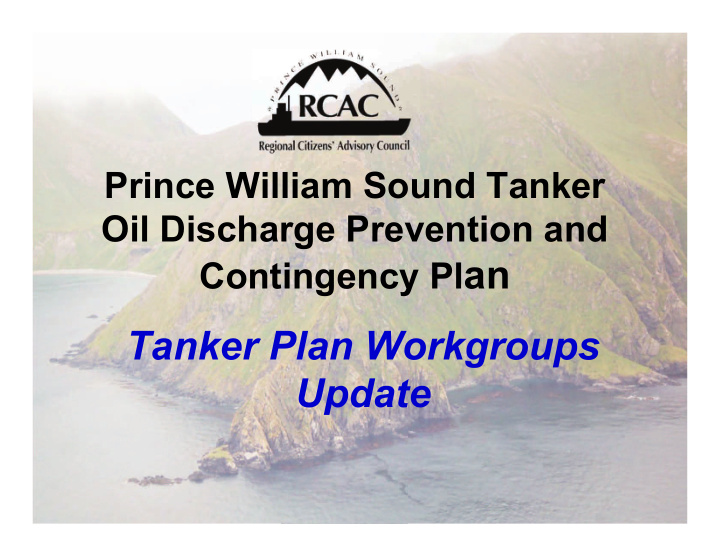



Prince William Sound Tanker Oil Discharge Prevention and Contingency Pl an Tanker Plan Workgroups Update
PWS Tanker Plan Workgroups Workgroups: Oil Properties Workgroup • • Nearshore Workgroup Staff: • Joe Banta • Tom Kuckertz • Roy Robertson • Jeremy Robida • Donna Schantz • Linda Swiss
PWS Tanker Plan Workgroups Oil Properties Workgroup Members: Contractors: • Response Planning • SL Ross Group • Spill Science • Alyeska/SERVS – Environment Canada • Alaska Dept. of Environmental Conservation • US Coast Guard • PWSRCAC
PWS Tanker Plan Workgroups Oil Properties Workgroup Two Phases: • Initial Charter 2009 -Sample taken February 2010 • Second Charter 2012 -Sampling protocol -Sample taken November 2012
PWS Tanker Plan Workgroups Oil Properties Workgroup Goals of Workgroup: • Analysis of current ANSC properties • Develop sampling protocol • Determine weathered oil properties • Effects of weathered oil and skimmers
PWS Tanker Plan Workgroups Oil Properties Workgroup Summary of Workgroup Process and Results: • Samples drawn – 2010 & 2012 • Analysis by SL Ross and Spill Science (Environment Canada) • Relatively consistent results
PWS Tanker Plan Workgroups Oil Properties Workgroup Summary of Workgroup Process and Results: • Sampling protocol established • Sampling frequency recommended • Oil properties defined
PWS Tanker Plan Workgroups Oil Properties Workgroup Oil Properties Summary: • Oil will not form a stable emulsion even when weathered • API 30.6 and 31.4 for 2012 sample • Workgroup reports were accepted by Steering Committee in August 2013
PWS Tanker Plan Workgroups Nearshore Workgroup Members: • Response Planning Group (shipper reps) • US Coast Guard • Alyeska/SERVS • PWSRCAC • Alaska Dept. of Environmental Conservation
PWS Tanker Plan Workgroups Nearshore Workgroup – 2011 • Analysis of nearshore components • Focus on Nearshore Task Forces 1-8 (72 hours) • Reviewed: – Historical documents – Job aids – Nearshore response tactics – Anvil study • RPS for Nearshore response is 12,265 bbls of oil within 72 hours
PWS Tanker Plan Workgroups Nearshore Workgroup November 2012 Plan: • Chart showing task force configuration replaced by multiple tactics that build on each other • Operational timeframes defined • No reduction in equipment (skimmers, boom, storage), fishing vessels • Maximize flexibility!
PWS Tanker Plan Workgroups Nearshore Workgroup Workgroup recommendations: • Change in operational timeframe – average 36 hours for NSTF 2-4 • Revised equipment table to show minimum equipment required for NSTF • Equipment deployment from Barge 500-2 • Minibarge towing speed • Operating during hours of darkness • Minibarge discharge containment
PWS Tanker Plan Workgroups Nearshore Workgroup Workgroup recommendations (con’t): • Debris management • Use of support vessels • Vessel decontamination • Skimmer operations tactic • Nearshore Group Supervisor • Staging areas and Barge 500-2 • On-site safety specialist
PWS Tanker Plan Workgroups Nearshore Workgroup Documents reviewed and bibliography created: • Exercise reports • Lessons learned • Anvil study • ADEC findings documents • Correspondence
PWS Tanker Plan Workgroups Nearshore Workgroup Current status: Draft Nearshore Work Group White Paper prepared – to be approved by Steering Committee
Questions?
Recommend
More recommend